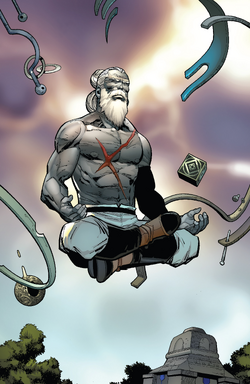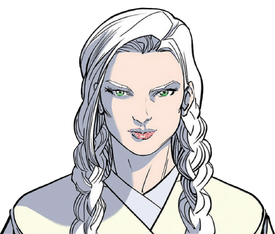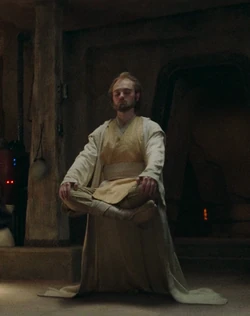- "I took the Barash Vow to live alone inside the Force, until my true path as a Jedi became clear."
- ―Kirak Infil'a

The Barash Vow saw a Jedi refrain from all activities within the greater Jedi Order.
The Barash Vow was an oath taken by Jedi who completely refrained from all activities related to the Jedi Order as a form of penitence, disengaging from anything but the Force itself and committing themselves to gain ultimate communion with it. Jedi Master Barash Silvain originated the practice, and the vow was named after her. Although most Jedi who swore the vow did so as a method of atonement, some did it in order to re-focus themselves on the Force.
Following the creation of the practice, many more Jedi took the vow over the years. In 232 BBY, the Jedi Knight Dez Rydan took the vow to re-focus himself on the Force after a traumatic experience with the dark side-steeped Drengir. After an incident on Brendok around 148 BBY, Jedi Master Torbin took the vow and remained in a meditative state for many years. In the late Republic Era, the Jedi Master Kirak Infil'a had taken the vow and survived Order 66 due to his adherence to the practice. During the years of his exile on Tatooine, Obi-Wan Kenobi took and kept the ways of the vow.
History[]
- "I cannot trust myself. I cannot allow you, or any other Jedi, to trust me. Not until I know I am hearing the Force clearly again. I will go."
"You're…leaving the Order?"
"No, Brother. I am still a Jedi and always will be. But until I regain my certainty…I must listen. I will take no action on behalf of the Order." - ―Barash Silvain and Porter Engle

Jedi Master Barash Silvain (pictured) was the namesake and originator of the Barash Vow.
In 382 BBY,[3] Jedi Master Barash Silvain accompanied her adopted brother Master Porter Engle on a mission to the planet Gansevor to resolve a conflict between the cities Firevale and Bethune. Silvain was tricked by Princess Sicatra of Bethune into escalating the conflict, as the Jedi Master was swayed by her own biases and did not listen to the Force. After Silvain realized her mistake and the conflict was resolved, she swore to Engle that she would take no action on behalf of the Jedi Order and isolate herself until she could trust herself and the Force again. Barash Silvain's choice became the practice known as the Barash Vow,[2] which was named after her.[4] From the founding of the Order to its doom, over fourteen thousand Jedi pursued Barash.[5]
Although primarily a method of atonement for terrible mistakes, some Jedi, such as Jedi Knight Dez Rydan, took the vow in order to re-focus themselves on the Force.[6] In 232 BBY,[7] After a traumatic experience as a prisoner of the dark side-steeped Drengir, Rydan chose to swear the vow and leave for a contemplation world. Rydan hoped to both recover from the damage the Drengir had inflicted on him and refocus his path on service instead of action and excitement.[6]

While taking the vow, Torbin remained in a state of silent levitation for over 10 years.
Jedi Master Torbin took the Barash Vow in response to an incident on Brendok[8] around 148 BBY.[9] As part of his vow, he eventually entered a silent levitating meditation in which the Force deflected any physical interaction with him. After over a decade in this state,[8] in around 132 BBY,[9] he was confronted by assassin Mae Aniseya, who warned him that she would kill him if he did not confess the crime he committed on Brendok to the Jedi High Council. Seeking forgiveness, Torbin broke his meditative state and killed himself by consuming a concoction provided by Aniseya, which contained the poisonous substance bunta.[8]
During the late Republic Era, Jedi Master Kirak Infil'a was a Barash-taker who was not killed by the execution of Order 66[5] in 19 BBY[7] due to his adherence to the vow. Knowing that the vow required disengagement from anything but the Force and thus would not allow Infil'a to react to the event, Sith Lord Darth Vader hunted him down,[5] finding him on the planet Al'doleem. There, Infil'a spent his Barash meditating while levitating on top of the sacred Jedi mountain Pasvaal. While sparring with his droid Arex, Infil'a reaffirmed his decision not to go into hiding and sensed Darth Vader's imminent arrival in the Force. After Infil'a stared down Vader from the mountain and resisted the Sith Lord's Force attacks, Vader confirmed that he had killed the other Jedi and planned to kill Infil'a as well. In response, Infil'a declared his Barash complete, deciding that his new path ended with killing Vader.[1] However, their duel ended with Vader killing him instead.[10]
Obi-Wan Kenobi took and kept to the ways of the vow during the years of his exile on Tatooine until leaving the planet to heed Princess Leia Organa's call for aid with his former apprentice's son, Luke Skywalker.[11]
Behind the scenes[]
- "The Vow is taken by Jedi who feel they have done something deeply wrong – particularly a misinterpretation of what they believed the Force wanted them to do – and while they don't leave the Order, they decide to sit and listen to the Force until they better understand themselves and what it's saying."
- ―Charles Soule
The Barash Vow first appeared in the second issue of the comic series Star Wars: Darth Vader (2017), which was written by Charles Soule[5] and released on June 21, 2017.[13] According to Soule, a Jedi undertaking a Barash Vow would not take on a Padawan learner.[14]
Star Wars: The High Republic — The Blade depicts the Barash Vow being created after the mission on Gansevor,[2] however Star Wars: The High Republic: Chronicles of the Jedi places it after the Siege of Bardotta.[4] This article assumes the former to be the correct flow of events.
On Instagram, Soule expressed his enjoyment of the Barash Vow's appearance in The Acolyte, recounting the Vow's origins both in and out-of-universe. Soule also clarified that the practice had been adopted by Jedi before and after its namesake, Barash Silvain, a fact that has yet to be stated by any canon source.[12]
Appearances[]
- The High Republic — The Blade 4
- The High Republic: Into the Dark
- The High Republic: Into the Dark audiobook
- The High Republic: The Eye of Darkness (Mentioned only)
- The High Republic: The Eye of Darkness audiobook (Mentioned only)
 The Acolyte — "Revenge / Justice"
The Acolyte — "Revenge / Justice"- Darth Vader (2017) 2 (First appearance)
- Darth Vader (2017) 3
- Darth Vader (2017) 4 (Mentioned only)
Sources[]
 Star Wars Helmet Collection 69 (Weapons & Uniforms: The Jedi Purge)
Star Wars Helmet Collection 69 (Weapons & Uniforms: The Jedi Purge)- Skywalker: A Family at War
 Star Wars Celebration LIVE! – DAY 1 on the official Star Wars YouTube channel (content now obsolete; backup link)
Star Wars Celebration LIVE! – DAY 1 on the official Star Wars YouTube channel (content now obsolete; backup link) Star Wars: The High Republic For Light and Life Panel | Star Wars Celebration Anaheim 2022 on the official Star Wars YouTube channel (backup link) (Posted on StarWars.com)
Star Wars: The High Republic For Light and Life Panel | Star Wars Celebration Anaheim 2022 on the official Star Wars YouTube channel (backup link) (Posted on StarWars.com) SWCA 2022: 10 Things We Learned From the Star Wars: The High Republic Panel on StarWars.com (backup link)
SWCA 2022: 10 Things We Learned From the Star Wars: The High Republic Panel on StarWars.com (backup link) Star Wars: The High Republic Show: Phase II Exclusive Reveals, a Visit to Dark Horse Comics, and More! on the official Star Wars YouTube channel (backup link) (Posted on StarWars.com)
Star Wars: The High Republic Show: Phase II Exclusive Reveals, a Visit to Dark Horse Comics, and More! on the official Star Wars YouTube channel (backup link) (Posted on StarWars.com)Celebrate The Heroes Of Star Wars In Peach Momoko's Women's History Month Variant Covers on Marvel Comics' official website (backup link)
- Star Wars: The High Republic: Chronicles of the Jedi
 Star Wars Celebration LIVE! 2023 – DAY 2 on the official Star Wars YouTube channel (content now obsolete; backup link)
Star Wars Celebration LIVE! 2023 – DAY 2 on the official Star Wars YouTube channel (content now obsolete; backup link)- Star Wars: Timelines
- Star Wars: The High Republic Character Encyclopedia
 "Revenge/Justice" Episode Guide | The Acolyte on StarWars.com (backup link)
"Revenge/Justice" Episode Guide | The Acolyte on StarWars.com (backup link) The Acolyte Explained | Highlights from "Lost / Found" and "Revenge / Justice" on StarWars.com (backup link)
The Acolyte Explained | Highlights from "Lost / Found" and "Revenge / Justice" on StarWars.com (backup link) What is the Barash Vow? on StarWars.com (backup link)
What is the Barash Vow? on StarWars.com (backup link) Barash Vow in the Databank (backup link)
Barash Vow in the Databank (backup link)
Notes and references[]
- ↑ 1.0 1.1 Darth Vader (2017) 3
- ↑ 2.0 2.1 2.2 The High Republic — The Blade 4
- ↑
 Star Wars: The High Republic Chronological Reader's Guide on StarWars.com (backup link) establishes that Phase II media of Star Wars: The High Republic chronologically begins with the novel The High Republic: Quest for the Hidden City. As Star Wars: The High Republic Character Encyclopedia dates the events of Quest for the Hidden City and the end of Phase II to 382 BBY, Phase II of The High Republic, which includes The High Republic — The Blade 4, must be set in that year.
Star Wars: The High Republic Chronological Reader's Guide on StarWars.com (backup link) establishes that Phase II media of Star Wars: The High Republic chronologically begins with the novel The High Republic: Quest for the Hidden City. As Star Wars: The High Republic Character Encyclopedia dates the events of Quest for the Hidden City and the end of Phase II to 382 BBY, Phase II of The High Republic, which includes The High Republic — The Blade 4, must be set in that year.
- ↑ 4.0 4.1 Star Wars: The High Republic: Chronicles of the Jedi
- ↑ 5.0 5.1 5.2 5.3 Darth Vader (2017) 2
- ↑ 6.0 6.1 The High Republic: Into the Dark
- ↑ 7.0 7.1 Star Wars: Timelines
- ↑ 8.0 8.1 8.2
 The Acolyte — "Revenge / Justice"
The Acolyte — "Revenge / Justice"
- ↑ 9.0 9.1
 "Lost/Found" Episode Guide | The Acolyte on StarWars.com (backup link) states that the events of The Acolyte take place 100 years before the events of Star Wars: Episode I The Phantom Menace, which Star Wars: Timelines dates to 32 BBY. Therefore, The Acolyte takes place in 132 BBY.
As the series establishes that the incident on Brenok occurred sixteen years before its events, it must have occurred around 148 BBY.
"Lost/Found" Episode Guide | The Acolyte on StarWars.com (backup link) states that the events of The Acolyte take place 100 years before the events of Star Wars: Episode I The Phantom Menace, which Star Wars: Timelines dates to 32 BBY. Therefore, The Acolyte takes place in 132 BBY.
As the series establishes that the incident on Brenok occurred sixteen years before its events, it must have occurred around 148 BBY.
- ↑ Darth Vader (2017) 4
- ↑ Skywalker: A Family at War
- ↑ 12.0 12.1
Charles Soule (@charlesdsoule) on Instagram: The Barash Vow (June 5, 2024): "The Barash Vow! It's always amazing when anything I make up in a comic or a novel finds its way into other kinds of storytelling, but this one was really special. As seen in THE ACOLYTE, Episode 2 - the Barash Vow, which we first saw taken by a character named Kirak Infil'a in Darth Vader #2, written by me and drawn by @giuseppe_camuncoli. The Vow is taken by Jedi who feel they have done something deeply wrong - particularly a misinterpretation of what they believed the Force wanted them to do - and while they don't leave the Order, they decide to sit and listen to the Force until they better understand themselves and what it's saying. It's named after Barash Silvain, a Jedi in the High Republic who took the Vow after a particularly egregious error. Jedi did this before her (and certainly after,) but her name became linked with it from that point forward. You can see that story in The Blade, a four-issue comic miniseries about Barash and her adopted brother Porter Engle, written by me and drawn by @mark_castiello and @jethro_morales Was really nice to see. #todaysgoodthing" (backup link (p/C71lc2Hx9oe) not verified!)
- ↑
Darth Vader (2017) #2 on Marvel Comics' official website (backup link)
- ↑
Charles Soule (@CharlesSoule) on Twitter: "I don't think someone who has taken the Barash Vow would think they had any business taking a padawan. (In response to: "Hello Mr. Soule. I'm a fan of your work. I have a question on the Darth Vader comic Jedi Kirak Infil'a. I know he had taken a vow of disengaging from the Jedi to focus on the Force but is it possible for him to still take on a padawan during his vow?")" (backup link)

